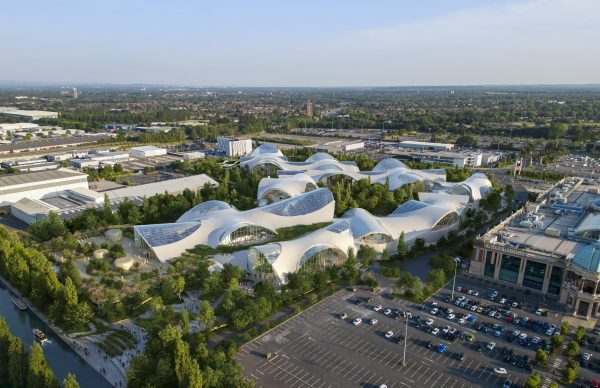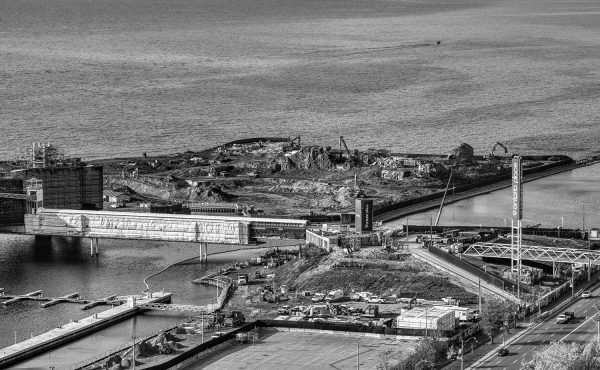The environmental critiques of Therme Canada’s mega-spa scheme have rightly focused on the project’s most visible and violent impacts: the clear-cutting of hundreds of mature trees on the West Island, the destruction of a migratory bird sanctuary, and the lake contamination caused by the inevitable dumping of huge quantities of chlorinated water. (The RFP for tree removal was posted late last week, with Ellis Don seeking firms that will cut down and remove over 800 trees.)
Yet such a sprawling and mostly glass encased structure filled with warm humid air and tropical plants will consume an enormous amount of energy for space and water heating, so another crucial environmental question posed by this project involves its reliance on natural gas for heating.
In its latest filings with the City’s planning department, Therme and its consultants have provided an energy plan that seems to be fitted out with cutting edge green systems, but is also troublingly vague about whether the company will actually employ them.
The highly technical 49-page document, prepared by Ensight Energy Solutions for Therme and submitted to the city, says the project’s “net zero emissions strategy” includes “opportunities” for features such as solar panels, geo-exchange-powered heat pumps, heat recovery equipment (to recycle energy from warm water), partnerships with the district energy firm Enwave, the use of renewable natural gas (i.e., gas from solid waste) and various LEED-related features. (The document can be found here and is entitled, “Energy Strategy Report.)
Aware that city officials want the project to satisfy Toronto Green Standard Tier 2 benchmarks for carbon reduction, Ensight offers all sorts of calculations showing estimated cost and carbon savings associated with a variety of low/no carbon technologies.
The report, however, never actually rules out the use of natural gas to drive boilers for heating water and doesn’t provide estimates on the carbon impact of such systems. “It is the project team’s aspiration to reduce building operational emissions to as close to zero as possible and further performance refinements will be investigated once the whole building energy modelling has commenced [emphasis added].”

In Manchester, where Therme Group is trying to develop another one of its spas, there are both clearer numbers and a more focused debate about the carbon footprint of the project. According to the company’s disclosures to Trafford City Council, the suburban Manchester municipality where the spa will be situated, the project will require 50,000 MWh of gas, which is about enough to provide space and water heating for about 3,000 homes.
The carbon released by all that natural gas is almost 22,000 tonnes — equivalent to the emissions from 22,000 typical cars over a three-month period. The water consumption, according to calculations by local environmental advocates, is equivalent to the amount used by more than 6,000 typical homes.
“This development,” as Climate Emergency Manchester noted in a recent blog post, “requires far more scrutiny by their planning committee than just waving it through. It needs firm commitments to reduce energy consumption and for that energy to be renewable if the development is fit for the future – so that it aligns with the climate emergency declaration and doesn’t undermine the Council’s carbon budgets for the borough. It should also radically rethink water consumption so it doesn’t abstract and discharge so much water.”
Adam Pierce, a spokesperson for the group, told me in an interview last week that Therme, which is in the process of re-submitting its application for a Manchester spa, has sought to persuade municipal planning officials to waive an environmental impact assessment. It’s exactly the same tactic Therme employed in Toronto, with claims made by both the company and government officials that it is somehow exempt from the provincial environmental assessment act.
So it is in Manchester: “They essentially want an opinion [from Trafford officials] that they don’t need to go through [the EIA] process even though we believe that there are significant impacts to the environment associated with this development,” says Pierce. “For me, that’s a warning flag that they are trying to just push this through as quickly as possible.”
His group has pointed out that if a developer wanted to build a subdivision that uses a comparable amount of carbon, it would certainly have to submit to an EIA.
“We calculated roughly what it meant in terms of the average household use of gas, and electricity, and it’s in the thousands, as well as the water usage. Essentially, at the moment, this project is like building a small town in Greater Manchester. If you built a small town, you’d get proper scrutiny and you’d have to go through an environmental impact assessment process.”
Therme had the green light to build a spa in Manchester pre-pandemic, but the application expired. Since then, says Pierce, Trafford council has shifted left and green. Like Toronto, it also declared a climate emergency during the pandemic, which Pierce says can’t be reconciled with a project like a mega-spa.

Local politicians, he cautions, “talk good sustainability talk [but] this doesn’t match up with that. We’re calling out the greenwash to the extent of you can’t say you’re committed to fighting and combating climate change whilst at the same time allowing developments like this with very little scrutiny.”
With the revised application now in the hands of the City of Toronto, the planning department has promised that its next report will include more specifics about the city’s infrastructure expectations, which of course includes the spa’s energy consumption, the embodied carbon in a structure that will be overwhelmingly made of glass and steel, and some clarity around what has to happen — both in terms of design and cost — for this structure to live up to the company’s rhetoric about a low/no carbon building.
It remains to be seen whether the planning department will recommend tough and enforceable energy efficiency measures, and whether Therme, which is keenly aware of who butters its bread, will actually make those investments or just talk the talk.
Mayor Oliva Chow last week did a bit of a quick pivot about Therme. But if she wants to fight the plan, as she claimed during the election, the spa’s massive carbon footprint offers yet another crucial reason to say, no thanks. Or at least to ensure that the Ontario government wears full responsibility for what will likely be an energy pig for decades.
Therme Manchester vs Therme Ontario Place
The Manchester Therme is proposed for the site of a now demolished convention space called Event City, located in a suburban mall/light industrial zone about half an hour’s drive outside the city’s core. It is part of a local economic development scheme called “Trafford Waters,” and is one of two proposed Therme sites in the U.K. The other is to be situated on a river-side industrial site in Glasgow. The developer in both cases is the Peel Group, an infrastructure, real estate and logistics asset manager. While the Manchester site is larger, the Ontario Place Therme will be higher, consume proportionally more water, and offer more than 50% more parking spaces, despite its proximity to transit.
- INDOOR AREA Manchester: 113,000 sq.-metres / Ontario Place: 87,000 sq.-metres
- PARKING Manchester: 1, 600 (surface) / Ontario Place: 2,700 (surface/below-grade)
- HEIGHT Manchester: 36 metres / Ontario Place: 45 m
- PUBLIC SPACE Manchester: 4,000 sq.-m / Ontario Place: 64,345 sq.-m (unapproved & unbuilt lake fill)
- GAS CONSUMPTION Manchester: 50,000 MW/hr / Ontario Place: no data
- ELECTRICITY Manchester: 25,000 MW/hr / Ontario Place: no data
- WATER USAGE Manchester: 2,180m3/day / Ontario Place: 1,909 m3/day
photos courtesy of Therme





